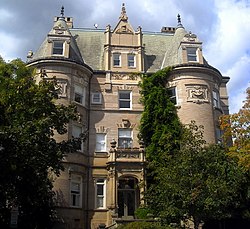Massachusetts Avenue (Washington, D.C.)
| Massachusetts Avenue SE Massachusetts Avenue NE Massachusetts Avenue NW | |
DDOT | |
| Width | 160 feet (49 m) |
|---|---|
| Location | Washington, D.C., U.S. |
| Coordinates | 38°54′50″N 77°3′11″W / 38.91389°N 77.05306°W |
| East end | Southern Avenue |
| Major junctions | |
| West end | Westmoreland Circle |
| Construction | |
| Completion | 1871 |
Massachusetts Avenue Historic District | |
 Miller House, a contributing property to the Massachusetts Avenue Historic District | |
| Location | Both sides of Massachusetts Avenue between 17th Street and Observatory Circle, NW |
| Coordinates | 38°54′50″N 77°3′11″W / 38.91389°N 77.05306°W |
| Area | 81 acres (33 ha) |
| Built | 1871 |
| Architect | Multiple |
| Architectural style | Late Victorian, Beaux Arts |
| NRHP reference No. | 74002166[1] |
| Added to NRHP | October 22, 1974 |
Massachusetts Avenue is a major diagonal transverse road in
Appearing in Peter Charles L'Enfant's original plan, Massachusetts Avenue crosses three of Washington's four quadrants.[2] It intersects every major north–south street and passes numerous Washington landmarks. It is a landmark itself, long considered the northern boundary of the downtown as well as home of Washington's Embassy Row.
Massachusetts Avenue is tied with Pennsylvania Avenue as the widest road in the District, at 160 feet (49 m). The two roads run in parallel through much of the city, Massachusetts about seven blocks north of Pennsylvania. Massachusetts Avenue was long Washington's premier residential street, as Pennsylvania was once its most sought-after business address. Both streets were named after states with prominent roles in the American Revolution: Massachusetts and Pennsylvania.
The historic district is an 81-acre (33 ha) area in northwest Washington that includes 150
Route description



The main section of Massachusetts Avenue begins at 19th Street
After briefly converging with
It intersects with
Massachusetts Avenue passes through the inner ring of
At
Other notable institutions located on Massachusetts Avenue include the
History

The track of the avenue was not paved until the administration of
The
Several overlapping historic district have been created to preserve the character of the remaining neighborhoods. The Massachusetts Avenue Historic District encompasses all buildings which front the road between 17th Street and Observatory Circle NW.
Transit
While no
Metrobus
The following Metrobus routes travel along the street (listed from west to east):
- N4 (Dupont Circle to Westmoreland Circle)
- N6 (Dupont Circle to Westmoreland Circle, making a clockwise-only loop each direction between Idaho Avenue westbound/Cathedral Avenue eastbound and Ward Circle. Runs on weekends and weekdays after 8 PM to replace N2 and N4 service)
- N2 (Dupont Circle to Idaho Avenue westbound/Cathedral Avenue eastbound, crossing again at Ward Circle)
- 80 (North Capitol Street to 2nd Street NW westbound/H Street NW eastbound)
- D6 (Stanton Park to North Capitol St.)
- X8 (Stanton Park to Columbus Circle)
- 96 (D.C. General Hospital to New Jersey Ave NW)
- M6 (Alabama Ave to Southern Ave)
D.C. Circulator
The
- Georgetown-Union Station (Columbus Circle to Mount Vernon Square)
Far western and eastern ends
Ride On Route 29 serves Massachusetts Avenue in Maryland from Westmoreland Circle to the avenue's terminus at Goldsboro Road.
The M6, which travels from the Potomac Avenue Metro station to Fairfax Village, runs along Massachusetts Avenue between Alabama Avenue and Southern Avenue.
Washington Metro
The following Metrorail stations have stops located near Massachusetts Avenue:
- Dupont Circle
- Mount Vernon Square
- Union Station
Commuter rail
- Amtrak:
- MARC:
- VRE:
See also
References
- ^ a b "National Register Information System". National Register of Historic Places. National Park Service. March 13, 2009.
- ISBN 978-0-9727611-0-9). The United States Code states in 40 U.S.C. 3309 Archived 2021-04-02 at the Wayback Machine: "(a) In General.—The purposes of this chapter shall be carried out in the District of Columbia as nearly as may be practicable in harmony with the plan of Peter Charles L'Enfant." The National Park Service identifies L'Enfant as Major Peter Charles L'Enfant Archived 2014-04-05 at the Wayback Machine and as Major Pierre (Peter) Charles L'Enfant Archived 2010-04-03 at the Wayback Machineon its website.
- ^ "Approve Street Extensions Archived 2021-10-04 at the Wayback Machine". The Washington Post. January 3, 1906. p. 11.
External links
- DC Preservation League. Massachusetts Avenue Historic District.
{{cite book}}:|work=ignored (help) - "Massachusetts Avenue Historic District". District of Columbia Office of Planning.
- Washington Places: Massachusetts Avenue at the Wayback Machine (archived April 25, 2015), a project at the University of Virginia School of Architecture
- National Park Service: Massachusetts Avenue Historic District Archived 2005-03-07 at the Wayback Machine
- Embassy.org Embassy Row Tour

